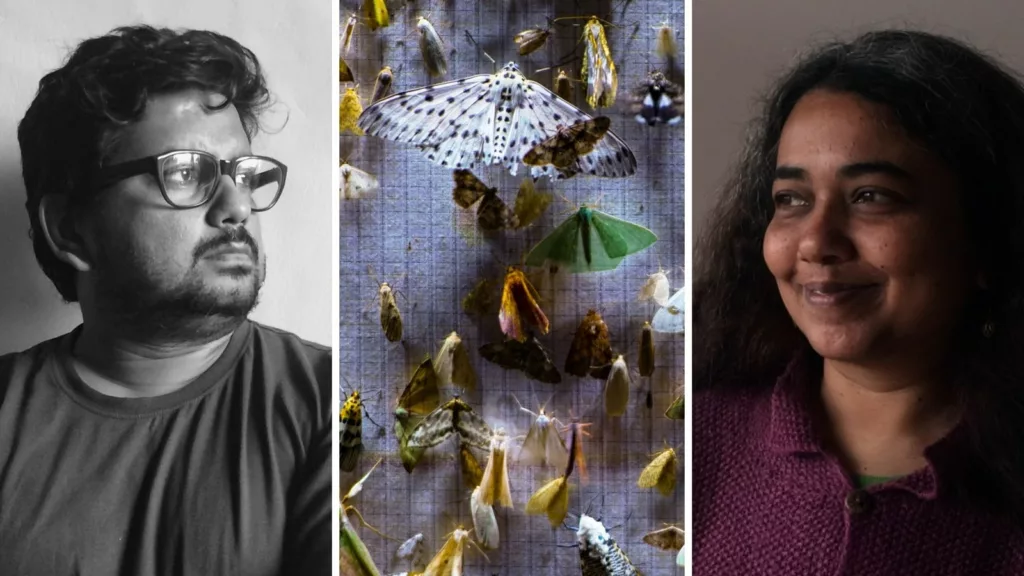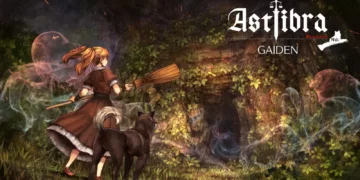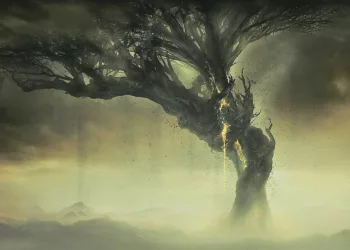The dim glow from hanging lanterns illuminates a vast white sheet stretching between the towering trees. Hundreds of delicate wings soon flutter onto the canvas, painting shapes across the checkered pattern. As night deepens its hold, two researchers patiently observe these arrivals, hoping to solve the puzzles presented by one miniscule species. Such is the scene that unfolds each lunar cycle in Anirban Dutta and Anupama Srinivasan’s exquisite documentary Nocturnes.
Guided by biologist Mansi Mungee and her assistant Bicki Marphew, this meditation delves into the mysteries of hawk moths residing high in India’s Eastern Himalayas. Through intimate footage and ambient sounds that transport the audience, Mungee’s longterm study of these insects and their environment comes to life after dark. As the camera lingers on swirling masses of wings or solitary subjects clinging to the sheet, details gradually emerge about her investigation into sizes, distribution and climate-linked behaviour.
With gentle patience, Nocturnes invites reflection on the interconnectedness within mountain ecosystems and innate beauty found even among creatures dismissed elsewhere as mere pests. All the while, Dutta and Srinivasan’s minimalist approach leaves room for personal discovery alongside Mungee in deciphering the messages left by shapes flickering against the moonlight.
Moonlight Serenades: Studying Moths in the Mountains
Up in the Eastern Himalayas, away from city lights, two intriguing characters embark on a nocturnal exploration every new moon. Led by ecologist Mansi Mungee, they set out to unravel the mysteries of hawk moths through close observation. Alongside her is Bicki Marphew, a member of the indigenous Bugun tribe who lends valuable local knowledge.
While most sleep, Mansi and Bicki suspend enormous white sheets between the towering trees. Then, they turn on lamps to illuminate the canvas against the night sky. Like iron filings drawn to a magnet, multitudes of moth wings shortly appear. Fluttering down to rest upon the chequered patterns, their tiny silhouettes emerge.
Patiently does Mansi study each arrival, identifying features that distinguish one from the next. Bicki assists, learning to see as she does. By morning, hundreds will have passed beneath their watchful eyes. Photographs and notes document every encounter for later analysis.
Back in her laboratory, Mansi examines the tapestry of images. With meticulous care, she measures and catalogs each moth. Their sizes, markings and locations all inform her long-running investigation. For she strives to understand how environmental changes impact these insects over time. Are they shifting upwards as temperatures warm? Does elevation affect their growth?
To find answers, Mansi returns to the mist-cloaked mountains each lunar phase. Once more setting out the silent orchestra of wings, her hopes are that one day, clues will emerge from the patchwork of photos accumulated through years of field work after dark. If hawk moths face threat from warmer slopes, she wants to know, and can then guide conservation of their delicate domain high in the peaks.
So on moonlit nights, Mansi and Bicki continue their serenades amongst the trees. Accompanied only by flickering lamps and whirring wings, they listen for responses from the tiniest musicians of the mountains.
Wafting Wings in the Mist
Nocturnes revels in the quiet beauty of nature through its evocative visuals. The cinematography works like the night itself, drawing viewers deep into the slumbering forest.
Up close, Satya Rai Nagpaul’s camera breathes life into the minute world of moths. Through intricate macro shots, each insect becomes a work of art. Furry coats, jewel-toned patterns – their intricate forms demand exploration. As viewers lean in alongside Mungee, details that escaped notice emerge with discovery’s joy.
In sweeping panoramas, the mountainsides surround like a whispering audience. Lush valleys and mist-cloaked slopes immerse the audience within the landscape. Dark earth and weeping foliage form a tapestry that’s as much character as setting. Whether framed alone or bustling with life, the unspoiled wilderness speaks through patient observation.
Light plays a starring role too, casting an ethereal glow through the trees. Screens illuminate the charcoal backdrop, a beacon summoning wings in the witching hour. Come sunrise, fog veils the world in dreamlike filter. Nature seems suspended between realities, eternal even as colors shift.
Complementing the visuals, ambient sound transports the audience. An orchestra of chirrups and buzzes speaks a language beyond words. Only occasionally does Mansi’s voice cut through, as ephemeral as the landscape it observes. Instead, her work echoes in the whirring wings whose music fills the soul.
Through its thoughtful compositions and shifts between macro and macro, Nocturnes weaves a spellbinding tapestry. The camera’s lingering gaze allows viewers to see, and to feel, the intricate beauty in the everyday magic of nightfall in the mountains.
Studying Silent Signals
Nocturnes explores important themes without heavy-handedness. Through gentle observation of moths and their habitats, it relays thoughtful ideas about nature.
Mansi works to lift the veil on lives most overlook. Her research spotlights nature’s minute players, showing insects as complex as any animal. Viewers lean in, discovering each moth’s intricate form. We learn they serve vital roles, like any creature, in the forest’s rhythms.
Subtle signals also suggest impacts facing such delicate interdependence. Abnormal migrations and changing sizes back concerns over warming temperatures. Yet Nocturnes avoids ominous music or captions. Instead, it presents these clues naturalistically, through measured study.
The film trusts its audience to follow subtle leads. It conveys environmental care through patience, stillness and care for overlooked lives. Viewers absorb thoughtful messages by focusing alongside Mansi and Bicki, not from outward persuasion.
Their collaborated work shows respect for indigenous knowledge, too. Local communities know the land, strengthening science with tradition.
Overall, Nocturnes nurtures observation and quiet reflection and their rewards. It engages viewers in considering nature’s silent conversations, and our role in listening. With subtle artistry, it encourages care for intricate worlds beyond our own.
By prioritizing thoughtful portrayal over didacticism, Nocturnes inspires viewers to draw their own understanding. It suggests how appreciation, not alarm, can best motivate care for fragile threads binding all living things.
Sharing the Silent Study
Nocturnes engages through total immersion in its natural setting. Minimal narration lets viewers discover the forest alongside Manni and Bicki. Their considered approach invites steady focus, not brief glimpses, helping subtler insights emerge.
Just hanging with the characters and camera feels refreshing. No summaries interrupt moments that might otherwise pass unnoticed. Details stand out, whether color shifts as dawn approaches or an insect’s acrobatic flight. With patience comes noticing, and noticing prompts questions.
Night scenes illuminate wonders hidden from hurried viewing. Varied wings come alive in their natural habitat, not an educational display. Their graceful acrobatics seem all the more striking for simply being observed, not explained. One appreciates each moth’s uniqueness instead of dismissing any as identical.
Shared time with the researchers deepens investment in their work. Their careful study gains significance as its subject’s complexity becomes clearly astonishing. Questions surface of how these intricate lives intersect with climate shifts seen through measured change.
Immersive visuals immerse one as completely as the natural sounds. Each sensory element builds a vivid world slowly, inviting thoughtful presence rather than passive watching. Details emerging at their own pace foster discovery, not demands for solutions.
By showing open study without concluding arguments, Nocturnes allows natural enormity, fragility and wonder to move the viewer. It trusts patience and presence to cultivate quiet caring better than dire warnings. Through total atmospheric absorption, it cultivates new insight into lives often overlooked.
Moths to a Flame
Nocturnes forges a singular cinematic experience, hypnotically immersing viewers in its forest world. Dutta and Srinivasan craft a delicate portraiture of life interconnected through elegant imagery and ambient sounds. Mansi and Bicky’s diligent nightly study subtly spotlights nature’s fragility while highlighting resilience within community relationships.
Scenes unveiled an astounding diversity of moth species, yet the film prioritized presence over explanations. Viewers savored moments that might otherwise pass unnoticed, noticing subtleties and pondering questions prompted by patient observation. Mansi’s research significance became clearer as moths’ intricacy astonished given attentive viewing. Her collaboration with local people also merits deeper discussion to better understand impacts.
Impressions linger of beings engaging scientific work not as detached observers but with profound respect for the living beings and landscapes sustaining all. Mansi’s philosophical conversations hinted at seeing beyond differences to recognize shared hopes. Bicky’s changing views perhaps suggest openness grows from time spent understanding others. Their quest inspires appreciation for nature’s wonder while emphasizing humanity’s responsibility as stewards.
Details about climate impacts flagged by moths’ migration remain unanswered. Yet Nocturnes presents a call to action through atmosphere rather than arguments. It trusts thoughtful presence over analyses to cultivate care for often-overlooked lives. Viewers may feel moved to consider personal roles in addressing global changes affecting even high Himalayan regions.
Nocturnes weaves a cinematic spell, pulling audiences into the night forest as irresistibly as its glowing sheets draw moths. Dutta and Srinivasan craft an enchanting display of life’s beauty that stirs quiet contemplation on connections linking all Earth’s inhabitants. Their unique creative vision merits the widest audience to experience the magic of discovering nature’s poetry through patient observation. Moths will have found their ideal advocates in this hypnotic and hope-filled film.
The Review
Nocturnes
In vivid yet understated fashion, Nocturnes weaves a spellbinding cinematic tapestry that pulls viewers into deep appreciation for the subtle wonders of nature. Through patience and careful observation, it cultivates quiet contemplation on our shared stake in environmental protection. Dutta and Srinivasan craft a lyrical ode to biodiversity that stimulates the senses and stays with the soul long after.
PROS
- Immersive and poetic cinematography that transports the viewer
- Thoughtful, minimalist storytelling allows nature to take center stage
- Subliminal messages about climate change impact and environmental stewardship
- Intimate portrayal of scientific field research and local collaboration
- Stimulates senses and promotes attentive observation of the natural world
CONS
- Slow, deliberate pace may not appeal to all audiences
- Some questions around climate impacts and research outcomes remain unanswered
- Heavy focus on processes over explanations at times

























